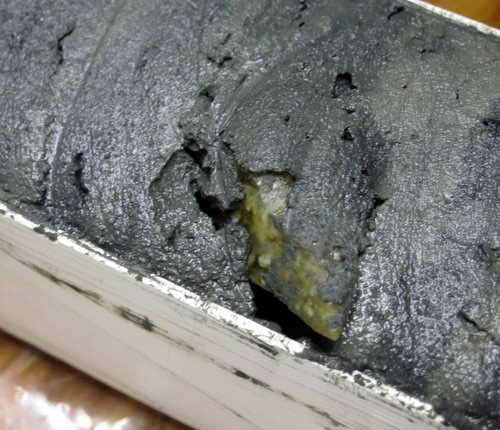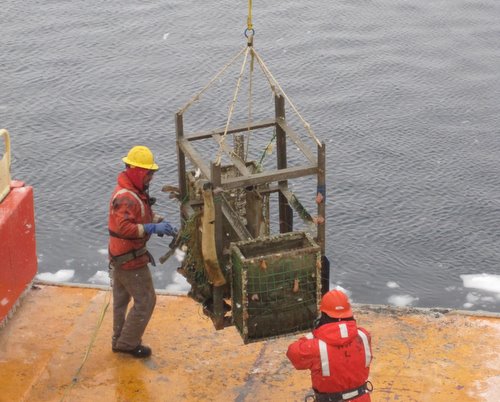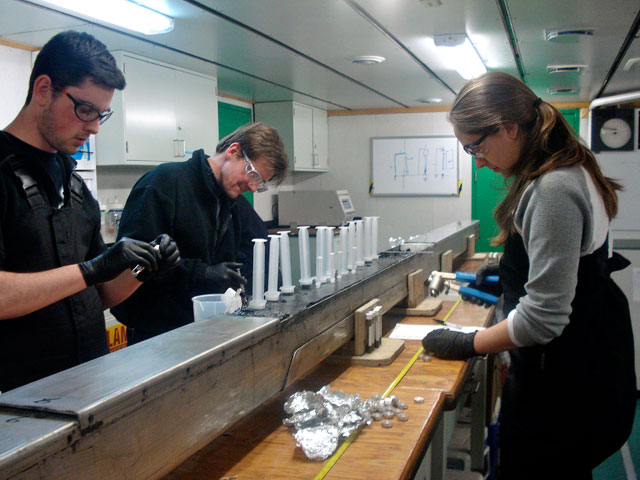Page 3/3 - Posted June 8, 2012
Drilling for ikaiteAnother rare phenomenon in the Southern Ocean proved a little less elusive. Several shallow sediment cores taken by a device called a Kasten corer from the seafloor contained the rare metastable mineral ikaite, a calcium carbonate that forms under near-freezing conditions that scientists are beginning to use to tease out information about climate and even ice cover in the past as another way to construct a paleoclimate record. “Our interest in ikaite is related to its very limited geographic occurrence and the interpretation, in the geologic literature, of its pseudomorph, glendonite, as a paleo-indicator of ‘Antarctic-like’ conditions in ancient rock sequences,” Leventer explained. The exact conditions under which ikaite — looking a bit like Kryptonite — forms and morphs into other minerals are still a mystery to science, according to McCormick. 
Photo Credit: Amber Lancaster (PolarTREC 2012), Courtesy of ARCUS
An ikaite crystal in a sediment core from the seafloor.
“There’s quite a bit of interest in learning about how these crystals are formed, so if we have a contemporary model of ikaite formation, then when we find these older ikaites, we have some idea of the actual conditions under which they were made,” he said. One common denominator, aside from extremely cold waters, is organically rich sediments, Leventer added. “But these two qualities characterize many more regions of the Antarctic continental margin than sites where ikaite is found,” she said, “so a project goal is to capitalize on the interdisciplinary nature of our research team to study the new cores that contain ikaite, using as many tools as possible.” McCormick said there are a number of possibilities that may be involved in ikaite formation. For instance, there are high concentrations of ammonium in the cores containing ikaite, along with methane and sulfur. “[The sediment cores] were actively off-gassing and hissing. You could see the mud squeezing out between the panels. We had to work very quickly to get our samples,” he said. “You could tell when we got one of these cores up. The whole back half of the ship reeked of sulfide.” The assumption is that the ikaite mineralization process is abiotic, without any biological participation, but microorganisms have been known to play a role in the formation of other minerals, McCormick noted. “We’re looking at the microbial community right at those levels where the ikaite is being formed,” he said. Landing biological specimensMicrobes to larger marine fauna are the subject of an altogether different experiment involving a whale carcass that had been purposefully left on the seafloor in the Antarctic Sound back in 2010. 
Photo Credit: Amber Lancaster (PolarTREC 2012), Courtesy of ARCUS
The whalebone lander is brought aboard the ship.
Based on a hypothesis first pioneered by Smith about 20 years ago, sunken whale corpses, also known as whale falls, are thought to serve as a catalyst for exotic marine critters capable of existing in extreme environments. In fact, the carcasses can be seen as another sort of proxy — in this case, for the elusive cold-seep communities. The first LARISSA cruise had left behind a pile of whalebones in a lander, an aluminum frame surrounded by an acoustic release that grips ballast. A coded ping from the ship triggers the acoustic release, bringing the now-buoyant lander to the surface. The researchers discovered that indeed some of the same suspects known to inhabit cold-seep communities made a home on the whale carcass, including different species of marine worm. McCormick’s microbes also play an important part in this micro-ecosystem, from the surface to within the core of the bone. The latter appear to thrive in anoxic environments, with the ability to use the fatty lipids in the bones. “It’s a nice story,” McCormick said. “We’re getting a nice idea of how the microbial communities structure themselves within the whalebone to optimize the retrieval of nutrients and energy out of the components of the bone.” Even the oceanographers benefitted from recovering the whale lander, which had refused to budge during an earlier attempt to retrieve the experiment during the southbound trip. “We also recovered a temperature-pressure record from a whalebone lander … yielding a very nice two-year record of bottom temperature in the Sound,” Huber said. “It showed a very dramatic seasonal signal, with the water at the bottom [at 1,000 meters] reaching near-freezing temperatures during the winter months.” Continuing the adventureThe LARISSA story is not over yet. The research team has one more expedition planned in 2013 under the current proposal — a trip aboard the new South Korean research vessel Araon, a 109.5-meter-long icebreaker commissioned in 2009. The scientists will hope the third time is indeed the charm next year. NSF-funded research for the LARISSA program: Eugene Domack, Hamilton College, Award No. 0732467 |



For USAP Participants |
For The Public |
For Researchers and EducatorsContact UsU.S. National Science FoundationOffice of Polar Programs Geosciences Directorate 2415 Eisenhower Avenue, Suite W7100 Alexandria, VA 22314 Sign up for the NSF Office of Polar Programs newsletter and events. Feedback Form |


